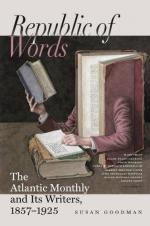Though these pageants were diverse in their origin,
they had, at the epoch of which we write, begun to
be confounded; and the Morris exhibited a tendency
to absorb and blend them all, as, from its character,
being a procession interspersed with dancing, it easily
might do. We shall hardly find the Morris pure
and simple in the English May-game; but from a comparison
of the two earliest representations which we have
of this sport, the Flemish print given by Douce in
his “Illustrations of Shakspeare,” and
Tollett’s celebrated painted window, (described
in Johnson and Steevens’s Shakspeare,) we may
form an idea of what was essential and what adventitious
in the English spectacle. The Lady is evidently
the central personage in both. She is, we presume,
the same as the Queen of May, who is the oldest of
all the characters in the May games, and the apparent
successor to the Goddess of Spring in the Roman Floralia.
In the English Morris she is called simply The Lady,
or more frequently Maid Marian, a name which, to our
apprehension, means Lady of the May, and nothing more.[14]
A fool and a taborer seem also to have been indispensable;
but the other dancers had neither names nor peculiar
offices, and were unlimited in number. The Morris,
then, though it lost in allegorical significance,
would gain considerably in spirit and variety by combining
with the other shows. Was it not natural, therefore,
and in fact inevitable, that the old favorites of
the populace, Robin Hood, Friar Tuck, and Little John,
should in the course of time displace three of the
anonymous performers in the show? This they had
pretty effectually done at the beginning of the sixteenth
century; and the Lady, who had accepted the more precise
designation of Maid Marian, was after that generally
regarded as the consort of Robin Hood, though she
sometimes appeared in the Morris without him.
In like manner, the Hobby-Horse was quite early adopted
into the Morris, of which it formed no original part,
and at last even a Dragon was annexed to the company.
Under these circumstances we cannot be surprised to
find the principal performers in the May pageants
passing the one into the other,—to find
the May King, whose occupation was gone when the gallant
outlaw had supplanted him in the favor of the Lady,
assuming the part of the Hobby-Horse,[15] Robin Hood
usurping the title of King of the May,[16] and the
Hobby-Horse entering into a contest with the Dragon,
as St. George.
We feel obliged to regard this interchange of functions among the characters in the English May-pageants as fortuitous, notwithstanding the coincidence of the May King sometimes appearing on horseback in Germany, and notwithstanding our conviction that Kuhn is right in maintaining that the May King, the Hobby-Horse, and the Dragon-Slayer are symbols of one mythical idea. This idea we are compelled by want of space barely to state, with the certainty of doing injustice to the learning and ingenuity with which the author




